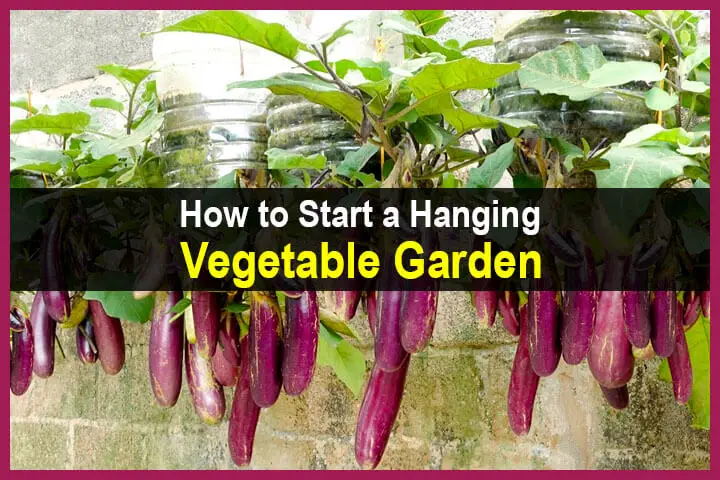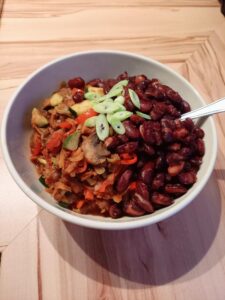Estimated reading time: 19 minutes
A hanging vegetable garden is simply an assortment of vegetable plants suspended above the ground in various ways. Some variations are referred to as vertical gardens.
There are numerous benefits and a few challenges but for anyone trying to increase the yield from their gardening efforts, or don’t have the benefit of a yard or traditional vegetable garden a hanging garden is an idea worth exploring.
Want to save this post for later? Click Here to Pin It On Pinterest!
Why Consider a Hanging Garden?

One of the unique benefits of growing vegetables in a hanging garden is that they are highly portable. You can start your garden indoors in winter and easily move the plants outdoors to either an apartment patio or in various areas around your yard and other gardens.
A hanging garden also allows you to grow a diversity of vegetables assuming you’ve planted varieties that will thrive in the confines or a pot or other suspended container.

It’s also easy to move your hanging plants around to give them more sun, shade or proximity to similar varieties for pollination. If one plant exceeds your expectations and grows too large you can either prune it or move it. There’s always flexibility unlike a garden in the ground that is difficult to move or transplant without putting stress on the plant.
Finally, a hanging garden makes disease control easier to manage. If a bloom of fungus shows up on a plant you can simply discard it, or isolate it somewhere while you treat it with a fungicide. In a traditional garden any disease can quickly spread both across the leaves and throughout the soil. Individual plants in containers isolate both plants and soil from other plants.
Hanging Garden Challenges

One of the primary challenges with any hanging garden setup is watering. There are various designs for containers that can hold and contain water to varying degrees, but a suspended pot or container will rarely retain water as well as the soil in a traditional garden.
Another challenge is related to the size of the pot or container. Plants need a certain amount of soil volume or the roots will become bound or stunted affecting the health of the plant. Selecting the right variety can help and making sure you have a rich soil mix is always a good idea. We’ll cover the best vegetable varieties and other considerations for the best results as we continue to explore this concept.
Hanging Garden Options

There are a lot of ways to design and arrange vegetable plants in a hanging garden. One of the first considerations is the type of container or structure you would use to hang or suspend your vegetables.
Hanging Flower Pots

This is the basic container for a hanging planter most people use to hang any plant. They usually feature a pot with holes in the bottom and a hooked tripod arrangement leading up to a large hook to simply hang the pot. The sizes vary but a 6-inch diameter pot is about the minimum for a vegetable plant.
Smaller pots work great for herbs and dwarf vegetable varieties while larger pots can accommodate larger vegetable plants like tomatoes.
Hanging Baskets

The hanging basket configuration creates a wider growing area and is usually lined at the bottom with a layer of hemp or other natural material like coconut fiber to hold the soil in a wire frame.
They don’t retain water well but for leafy greens like lettuce, kale and spinach they prevent too much moisture build up that could lead to fungus or root rot. Both of those diseases are common with green, leafy vegetables and a hanging basket can avoid that problem.
Hooked Pots or Baskets

There are containers designed with a hook on the back that allows you to hang the plant on a trellis, over a fence, railing or any other structure that can support the hooks.
Trellis and Pergolas

Many vegetables grow on vines and you can use a trellis or the larger structure of a pergola to support the vines while the plant either grows from the ground or a pot or container attached to the bottom of the trellis. In this case the fruits and vegetables are literally hanging down.
An arched trellis is a great way to grow grapes and the shape will allow the grape bunches to hang down from trellis hoop for an easy harvest in an attractive setting. The top of a pergola can serve the same function.
Large vining gourds like cucumber, winter and summer squash and even some of the smaller melons like cantaloupe and miniature watermelons can climb a trellis or lattice and successfully bear fruit. They might need a slight larger pot suspended or attached towards the bottom, or can even be planted in the ground and trained up the trellis.
Hanging Bag Planters

Hanging bag planters are often designed with multiple slots cut into the sides of the bag. Strawberries are often grown this way as well as herbs and even root vegetables like radishes, beets and carrots.
The long length of the bags make it easy to grow long and deep root vegetables and the spreading roots of strawberry plants eventually find their way and emerge from every slot cut into the bag.

Bag planters with multiple slots are also an excellent way to grow mushrooms and many mushroom varieties will continually produce crop after crop even after harvest.
Hanging Trays

There are long trays with hooks that can be hung on any sturdy horizontal structure from trellises to fences, lattice or any other support you improvise that can support the trays.
These are great for planting a row of vegetable crops similar to the rows you would plant in a traditional vegetable garden. The depth isn’t always so great so think about vegetables with shallow roots like leafy greens, or shallow root vegetables like radishes and beets. Bush beans are another possibility.
One other possibility is to plant pole beans in a hanging tray attached to the bottom of a trellis or lattice. The vines will grow up the trellis or lattice while the roots of the plants are watered and fed from the bottom tray.
You can also plant multiple varieties and types of vegetables in these long trays, but keep an eye on companion planting so you plant vegetables that are compatible with each other. We’ll cover good companion vegetables in a chart a little bit later.
Build Your Own

You don’t have to buy anything for a hanging garden. You can build your own trays from wood scraps and attach them to a wall, fence or structure. In a pinch you could always use a 5-gallon bucket or 1-gallon paint can to make a hanging garden. Just use the handle on the bucket or can to hang the plant and punch some holes in the side at the bottom for drainage.
The Best Soil Mix for a Hanging Garden

As a general rule, you’ll want to create a rich, loamy soil mix to give your hanging plants the most nutrients in a small space. We’ll identify which vegetables prefer an acidic soil versus an alkaline soil in the chart, but the more you can enrich the soil the better your plants will develop.
You can buy soil mixes for vegetables in container but the standard recommendation is for a mix of 75% Peat Moss + 20% Vermiculite + 5% Perlite. If you have a compost heap you can substitute the peat moss with compost.
From a pH standpoint the safest soil pH is a somewhat neutral reading around 5.5 to 7.5. If the soil is too acidic towards the 0 end of the pH scale, the soil needs to be amended. The same is true if it is trending towards the high or alkaline end of the pH scale ending in 14.
A general rule is that you can add dolomitic lime to make soil more alkaline, Most cruciferous vegetables like Brussels sprouts and cauliflower prefer a soil with a pH of 6 to 7 which is about neutral from a ph standpoint.
If you want to make the soil move towards the acidic end of the pH scale a common recommendation is sulfur. Plants in the nightshade family like tomatoes, potatoes and peppers refer a slightly acidic soil of around 6 to 5.5.
Occasional feeding with a plant food like Miracle Grow or other plant foods also helps. Just make sure you read the directions so you don’t overfeed and burn the roots of the plant.
Watering considerations

Watering may be one of the biggest challenges with a hanging garden. Any suspended container requires some degree of drainage or the plants could become waterlogged resulting in root rot. As a result, regular watering is recommended at least daily and possible twice a day on particularly sunny and hot days.
There are containers that can be hung with attached cups or bases at the bottom that will retain water allowing the soil to wick-up into the container while keeping most of the soil relatively moist but not waterlogged.
You could also place a small plastic cup in the bottom of a pot or container to create a mini wicking bed. Some stones are placed in the cup at the bottom of the container, and the spaces between the stones will contain enough water to keep the soil moist. This could buy you an extra day if you miss watering on a daily basis.
Pruning

Some vegetable plants in a hanging garden will need to be pruned from time to time. Tomatoes are a good example especially if they’re not a dwarf variety like cherry and grape tomatoes. It’s all a matter of assessing the plant as it grows and if it seems like it’s overwhelming its hanging pot or basket – prune it.
What About Fruits?

Fruits can work to some degree but this isn’t about fruits that grow on trees or large bushes or canes. It’s about fruits that grow on fairly petite plants. The classic example are strawberries, dwarf blueberries, dwarf raspberries, dwarf blackberries and even cranberries.
And Then There’s Herbs…

Of all of the edible vegetables and fruits you can plant, herbs may be the hardiest and the best choice for a hanging garden. Most herbs are compact plants with shallow root systems and thrive in the confines of a smaller pot or container. There are some exceptions like dill and cilantro that can grow to 3 feet but if you harvest proactively and keep them pruned they’ll do fine in a hanging garden.
Better yet, many herbs are perennials including Rosemary, thyme, and oregano. And they don’t have to be perennials to keep growing. Just move your hanging pots and baskets indoors before the first frost and even delicate herbs like Basil and tarragon will continue to grow and produce through the seasons.
Best Vegetable Varieties for a Hanging Garden

Here’s the chart we mentioned earlier. We’ll cover the key vegetables that tend to do well in a hanging garden along with some other notes on the care and feeding of a hanging vegetable garden. We’ll also cover the best fruits and herbs.
| Vegetable | Sun or shade | Root depth | Soil Depth | Ideal soil pH | Companions to Avoid |
|---|---|---|---|---|---|
| Arugula | SHADE | shallow | 6-inch deep | 6.0 to 6.8 | Garlic and onions |
| Beets | SUN/ SHADE | medium | 6-inch deep | 6.0 to 7.5 | Beans |
| Bush Beans | SUN | deep | 12+ inches | 6.0 to 7.5 | Garlic and onions |
| Carrots | SUN/ SHADE | medium | 10 to 12 inches | 5.5 to 7.0 | Parsley |
| Chard | SHADE | shallow | 6-inch deep | 6.0 to 7.5 | Garlic and onions |
| Cherry or Grape tomatoes | SUN | medium | 10 to 12 inches | 6.2 to 6.8 | Herbs |
| Cucumbers | SUN | medium | 10 to 12 inches | 5.5 to 7.5 | Herbs |
| Garlic | SUN | shallow | 6-inch deep | 5.5 to 7.5 | Beans |
| Kale | SHADE | shallow | 6-inch deep | 6.0 to 7.5 | Strawberries and tomatoes |
| Lettuce | SUN | shallow | 6-inch deep | 6.0 to 7.0 | Broccoli |
| Onions | SUN | shallow | 6-inch deep | 6.0 to 7.0 | Beans |
| Peas | SUN | shallow | 10 to 12 inches | 6.0 to 7.5 | Garlic and onions |
| Peppers – all varieties | SUN | medium | 10 to 12 inches | 5.5 to 7.0 | Herbs |
| Pole Beans | SUN | deep | 12+ inches | 6.0 to 7.5 | Garlic and onions |
| Radishes | SUN/ SHADE | shallow | 6-inch deep | 6.0 to 7.0 | Potatoes |
| Spinach | SHADE | shallow | 6-inch deep | 6.0 to 7.5 | None |
| Summer Squash | SUN | medium | 10 to 12 inches | 5.5 to 7.0 | Herbs |
| Winter Squash | SUN | medium | 10 to 12 inches | 5.5 to 7.5 | Herbs |
| Herb | Sun or shade | Root depth | Container size | Ideal soil pH | Companions to Avoid |
|---|---|---|---|---|---|
| Basil | SUN | shallow | 6-inch deep | 7.0 (neutral) | Nightshades: tomatoes, peppers, squash |
| Bay Leaf | SUN | medium | 6-inch deep | 7.0 (neutral) | Nightshades: tomatoes, peppers, squash |
| Chives | SUN | shallow | 6-inch deep | 7.0 (neutral) | Nightshades: tomatoes, peppers, squash |
| Marjoram | SUN | shallow | 6-inch deep | 7.0 (neutral) | Nightshades: tomatoes, peppers, squash |
| Oregano | SUN | medium | 6-inch deep | 7.0 (neutral) | Nightshades: tomatoes, peppers, squash |
| Parsley | SUN | shallow | 6-inch deep | 6.0 to 7.0 | Nightshades: tomatoes, peppers, squash |
| Rosemary | SUN | medium | 10 to 12 inches | 7.0 (neutral) | Nightshades: tomatoes, peppers, squash |
| Tarragon | SUN | shallow | 6-inch deep | 7.0 (neutral) | Nightshades: tomatoes, peppers, squash |
| Thyme | SUN | shallow | 6-inch deep | 7.0 (neutral) | Nightshades: tomatoes, peppers, squash |
| Fruit | Sun or shade | Root depth | Container size | Ideal soil pH | Companions to Avoid |
|---|---|---|---|---|---|
| Cranberries | SUN | medium | 10 to 12 inches | 6.0 to 7.0 | Alliums: Garlic and onions |
| Currants | SUN | medium | 10 to 12 inches | 6.0 to 7.0 | Alliums: Garlic and onions |
| Dwarf blueberries | SUN | medium | 12+ inches | 6.0 to 7.0 | Alliums: Garlic and onions |
| Dwarf raspberries | SUN | medium | 12+ inches | 6.0 to 7.0 | Alliums: Garlic and onions |
| Gooseberries | SUN | medium | 10 to 12 inches | 6.0 to 7.0 | Alliums: Garlic and onions |
| Grapes | SUN | deep | 12+ inches | 6.0 to 7.0 | Alliums: Garlic and onions |
| Strawberries | SUN | shallow | 6-inch deep | 6.0 to 7.0 | Alliums: Garlic and onions |
If your favorite fruit, herb or vegetable didn’t show up in these charts that doesn’t mean you can’t plant it in a hanging garden. Just make sure you check for these parameters related to soil depth, determine the best container and other considerations and go ahead and give it a try.
Harvesting

Unlike a traditional garden where you may wait for a large crop to mature, it’s best to consistently harvest from a hanging garden. Mature plants demand more water, nutrients and sunlight and if you harvest the ripened vegetables, fruits and herbs as they mature you will make it easier for the plants to sustain themselves.
You may also find your plants bear more when they are harvested in a timely way.
Composting and Disinfecting for Next Crop

When a plant is finally done and starts to show signs of browning or dying off it’s time to dump the soil into the compost heap. It’s also important to thoroughly disinfect, wash and dry the pot or container in the event that some manner of disease has emerged or is lying dormant.
Hanging Garden Fails
Anyone who has ever hung a potted plant or flower knows a lot can go wrong. Here are some possible fails to avoid:
- Failure to regularly water. Depending on location and the size of the pot, a hanging garden is susceptible to rapid evaporation. Vegetables and fruits are particularly vulnerable as they grow and mature. Make sure you water on a regular basis and check the soil with your finger for dryness. A wicking cup in the bottom of the pot might give you some insurance.
- Failure to properly locate and position plants. Some plants like direct sun while others prefer shade or partial sun during the day. Keep an eye on your plants and make sure you have them in the best location. Remember that some plants particularly need sun as their fruits mature.
- Failure to use the proper container size. A container that is too small can cause many plants to become root bound. Keep an eye on the recommended soil depth for any plant and don’t over-plant in any given container.
- Failure to properly feed plants. Even with the richest soil mix any plant will consume nutrients over time. Remember to feed your hanging garden from time to time especially if you spot yellowing leaves or stunted fruits and vegetables.
- Failure to manage pests and disease. Just because they’re off the ground doesn’t mean that insects and disease can’t devastate your hanging garden. Keep an eye on your plants as you water, feed, prune or harvest and check for bugs or any signs of disease like mold, spotting, or yellowing. Fortunately you probably won’t have to worry about rabbits and other rodents too much.
- Failure to manage companion planting. Some plants grow better in close proximity to each other while others struggle when planted next to each other. A container keeps the roots not only close together but eventually intertwined. Make sure you only plant companion plants if putting multiple varieties in the same pot, basket or tray.
More Information About Hanging Gardens
Here are some great links to videos and articles about how to put together and tend to a hanging garden and pots in containers:
It’s a Good Idea

Even if you just hang a few plants on an apartment patio or put some around your deck or fence in the back yard, a hanging garden is an easy way to increase your vegetable and fruit yield; diversify your harvest or actually have a garden in an apartment building.
It’s also a portable planting solution that will extend your harvest time and total yield, and can give you some added opportunities for succession planting as the seasons go on. Just make sure you keep them watered and harvest frequently to keep them healthy.
Like this post? Don’t Forget to Pin It On Pinterest!


















